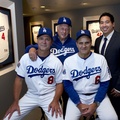Since 1998, Yuriko Gamo Romer’s Flying Carp Productions has been responsible for producing a variety of short and feature length documentaries focused on “encouraging community and peaceful existence by challenging audiences to think critically and sensitively about world issues.”1 Her first feature length film, Mrs. Judo: Be Strong, Be Gentle, and Be Beautiful, explored Keiko Fukuda’s journey to becoming the first woman to achieve Judo’s highest honor, the 10th degree black belt, in a male dominated sport. Romer’s current project, Diamond Diplomacy: U.S. Japan Relations Through a Shared Love of Baseball, now in post-production, examines the over 150-year history of America’s pastime in Japan, and the role it played in developing trans-pacific diplomacy between the two countries.
Since baseball’s introduction to Japan in 1872 by American teacher Horace Wilson, the game has grown to become Japan’s most popular sport.2 Romer’s Diamond Diplomacy chronicles this storied history through interviews with Masanori Murakami, the first Japanese-born player to play in the MLB, and Warren Cromartie, a former MLB player who played seven seasons in the NPB (Nippon Professional Baseball Organization).
Murakami began his career in Japan, signing with the Japanese Pacific League's Nankai Hawks at the age of 17. In 1964, he and two other Nankai Hawks prospects, Tatsuhiko Tanaka and Hiroshi Takahashi, were sent to the San Francisco Giants to learn from American coaches and players.3 All three would play for the Giants’ Class-A minor league team, the Fresno Giants, leading them to an 86-53 record.4 Murakami’s success in the minor leagues, an 11-7 record and 1.78 ERA (Earned Run Average), eventually led him to be called up to the Giants’ MLB ballclub. Murakami would play a total of 54 games for the San Francisco Giants during the 1964 and 1965 seasons, obtaining five wins and nine saves during his MLB career.5 In 1966, he returned to Japan due to contractual and family obligations, where he played baseball for 17 more years.6

On May 15, 2014, the San Francisco Giants honored Murakami on Japanese Heritage Night, which celebrated the 50th anniversary of his debut with the Fresno Giants.7 Romer attended the game, watching Murakami toss out the game’s ceremonial first pitch. At the time, Romer had already been thinking of making a baseball documentary about the San Francisco Seals’ 1949 goodwill tour to Japan. After filming the 2014 Japanese Heritage Night and interviewing Murakami, Romer realized she could tell a much bigger and broader story about the U.S. and Japan’s intertwined baseball histories.
In 2017, Romer’s vision of the documentary continued to expand as she consulted for a U.S. Embassy-sponsored photo exhibition event showcasing the U.S. and Japan’s baseball histories. There she met and interviewed the event’s spokesperson, Warren Cromartie, who began his baseball career with the Montreal Expos but transitioned to the Yomiuri Giants in 1984 after failed MLB contract negotiations. Romer recalls that the interviews with Cromartie were “colorful and animated” as he shared stories about his career. Cromartie averaged over 30 home runs in his first three seasons and was voted league MVP in 1989 after leading his team to win the Japan Series Championship against the Kintetsu Buffaloes.8

In addition to former baseball players, Romer also interviewed numerous baseball historians and researchers. Her conversations with authors Bill Staples Jr. and Kerry Nakagawa would provide her with an abundance of information regarding baseball's history within the World War II Japanese concentration camps. These stories led Romer to create a separate documentary short film, Baseball Behind Barbed Wire, released in 2023.
The film, focused on the Gila River concentration camp in Arizona, reveals how Kenichi Zenimura and his sons built a baseball field in the camp’s harsh desert environment with very limited resources. Kenichi Zenimura’s son, Howard, recalls the challenges of “trying to get water into the area … the hardest part was we dug a trench all the way to the laundry room and a person that was in camp was a plumber and connected the pipeline to the laundry room, we had to do it during the night time when nobody is using the facility. So, what we did was, shut down the mainline and connected the pipeline and that water was sent all the way to the back of the pitcher’s mound.”9
Despite the racism and hardships that the camp’s incarcerees faced during World War II, baseball offered a common ground that united them. According to Tetsuo Furukawa, who played for one of the camp’s many baseball teams, “[when the baseball field, commonly referred to as Zenimura Field, opened on March 7, 1943], it was a huge day for all the evacuees because there, this is America. We get to play baseball again, we didn’t have hot dogs or Coca Cola, but then we made the best of it … the camp director was invited, and he threw the first pitch out, we had a doubleheader that day. So, it was just like America again.”10
Since its debut in 2023, Baseball Behind Barbed Wire has participated in a variety of film festivals. The film has been well-received, winning an award for best cinematography at the 2023 United Nations Association Film Festival and being named Best Short Documentary at the Chandler International Film Festival. The film is now available for educational distribution through Good Docs, and Romer hopes to eventually obtain wider distribution. Based on the success of Baseball Behind Barbed Wire, it's a safe bet that Romer's upcoming feature-length documentary, Diamond Diplomacy: U.S. Japan Relations Through a Shared Love of Baseball, will also be a home run.
Notes:
1. Flying Carp Productions homepage, Flying Carp Productions (website), 2015, accessed February 24, 2024.
2. David Adler, “History of Baseball in Japan,” Major League Baseball, February 21, 2023.
3. Martin Stezano, “How MLB’s First Japanese Player Made it to the Big Leagues,” History, November 15, 2021.
4. Chris Blake, “Murakami’s Big League Debut Changed the Game,” National Baseball Hall of Fame, accessed February 24, 2024.
5. Masanori Murakami stats page, Baseball Reference, accessed February 24, 2024.
6. Martin Stezano, “How MLB’s First Japanese Player Made it to the Big Leagues,” History, November 15, 2021.
7. Henry Schulman, “Giants' Masanori Murakami, 50 Years Later,” SFGATE, May 17, 2014.
8. Norm King, “Warren Cromartie,” Society for American Baseball Research, accessed February 24, 2024.
9. “Baseball Behind Barbed Wire,” Diamond Diplomacy (website), accessed February 24, 2024.
10. “Baseball Behind Barbed Wire,” Diamond Diplomacy (website), accessed February 24, 2024.
© 2024 Kristopher Kato






